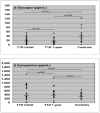Blunted glucagon but not epinephrine responses to hypoglycemia occurs in youth with less than 1 yr duration of type 1 diabetes mellitus
- PMID: 23992543
- PMCID: PMC3858506
- DOI: 10.1111/pedi.12070
Blunted glucagon but not epinephrine responses to hypoglycemia occurs in youth with less than 1 yr duration of type 1 diabetes mellitus
Abstract
Context: Glycemic control is limited by the barrier of hypoglycemia. Recurrent hypoglycemia impairs counterregulatory (CR) hormone responses to subsequent hypoglycemia.
Objective: To determine the glucagon and epinephrine responses to insulin-induced hypoglycemia in adolescents with recent-onset type 1 diabetes mellitus (T1DM).
Methods: We assessed the CR responses to hypoglycemia by performing a hyperinsulinemic (2.0 mU/kg/min), euglycemic (BG 90 mg/dL; 5.0 mmol/L)-hypoglycemic (BG 55 mg/dL; 3.0 mmol/L) clamp in 25 recent-onset (<1 yr duration) patients 9-18 yr old (mean ± SD: 13.4 ± 2.7) with T1DM and 16 non-diabetic controls 19-25 yr old (mean ± SD 23.3 ± 1.8). Twenty of the T1DM subjects were retested 1-yr (53 ± 3 wk) later.
Results: At the initial and 1-yr studies, peak glucagon (pGON) and incremental glucagon (ΔGON) during hypoglycemia were lower in the T1DM subjects [median pGON = 47 pg/mL (quartiles: 34, 72), ΔGON = 16 (4, 27) initially and pGON = 50 pg/mL (42, 70), ΔGON = 12 (9, 19) at 1-yr] than in controls [pGON = 93 pg/mL (60, 111); ΔGON = 38 pg/mL (19, 66), p = 0.01 and p = 0.004 for ΔGON at initial and 1-yr study, respectively]. In contrast, peak epinephrine (pEPI) and incremental epinephrine (ΔEPI) levels were similar in the T1DM (pEPI = 356 pg/mL (174, 797) and ΔEPI = 322 pg/mL (143, 781) initially and pEPI = 469 pg/mL (305, 595) and ΔEPI = 440 pg/mL (285, 574) at 1 yr) and in controls (pEPI = 383 pg/mL (329, 493) and ΔEPI = 336 pg/mL (298, 471) p = 0.97 and 0.21 for ΔEPI at initial and 1-yr study, respectively).
Conclusions: Even within the first year of T1DM, glucagon responses to hypoglycemia are blunted but epinephrine responses are not, suggesting that the mechanisms involved in the loss of these hormonal responses, which are key components in pathophysiology of hypoglycemia-associated autonomic failure, are different.
Keywords: children; counterregulation; epinephrine; glucagon; hypoglycemia; type 1 diabetes mellitus.
© 2013 John Wiley & Sons A/S. Published by John Wiley & Sons Ltd.
Figures


References
-
- The Diabetes Control and Complications Trial Research Group. . The Effect of Intensive Treatment of Diabetes on the Development and Progression of Long-Term Complications in Insulin-Dependent Diabetes Mellitus. N Engl J Med. 1993;329:977–986. - PubMed
-
- UK Hypoglycaemia Study Group. Risk of hypoglycaemia in types 1 and 2 diabetes: effects of treatment modalities and their duration. Diabetologia. 2007;50:1140–1147. - PubMed
-
- Donnelly L, Morris A, Frier B, et al. Frequency and predictors of hypoglycaemia in Type 1 and insulin-treated Type 2 diabetes: a population-based study. Diabet Med. 2005;22:749–755. - PubMed
Publication types
MeSH terms
Substances
Grants and funding
- UL1 RR024139/RR/NCRR NIH HHS/United States
- HD41908-10/HD/NICHD NIH HHS/United States
- U10 HD05652505/HD/NICHD NIH HHS/United States
- U10 HD056526/HD/NICHD NIH HHS/United States
- U10 HD041915/HD/NICHD NIH HHS/United States
- U10 HD041908/HD/NICHD NIH HHS/United States
- UL1 RR024150/RR/NCRR NIH HHS/United States
- UL1RR024979/RR/NCRR NIH HHS/United States
- U10 HD041906/HD/NICHD NIH HHS/United States
- UL1RR025744/RR/NCRR NIH HHS/United States
- U10 HD041918/HD/NICHD NIH HHS/United States
- HD41918/HD/NICHD NIH HHS/United States
- K12 DK094714/DK/NIDDK NIH HHS/United States
- UL1RR024992/RR/NCRR NIH HHS/United States
- UL1 RR024992/RR/NCRR NIH HHS/United States
- HD41915/HD/NICHD NIH HHS/United States
- HD41890-10/HD/NICHD NIH HHS/United States
- UL1RR024139/RR/NCRR NIH HHS/United States
- U01 HD041890/HD/NICHD NIH HHS/United States
- UL1 RR025744/RR/NCRR NIH HHS/United States
- KL2RR024994/RR/NCRR NIH HHS/United States
- UL1 TR001085/TR/NCATS NIH HHS/United States
- HD41906-10/HD/NICHD NIH HHS/United States
- UL1 TR000448/TR/NCATS NIH HHS/United States
- U10 HD041890/HD/NICHD NIH HHS/United States
- K12 DK094714-01/DK/NIDDK NIH HHS/United States
- HD56526/HD/NICHD NIH HHS/United States
- KL2 RR024994/RR/NCRR NIH HHS/United States
- UL1RR024150/RR/NCRR NIH HHS/United States
- UL1 RR024979/RR/NCRR NIH HHS/United States
- KL2 TR000450/TR/NCATS NIH HHS/United States
LinkOut - more resources
Full Text Sources
Other Literature Sources
Medical
Research Materials

